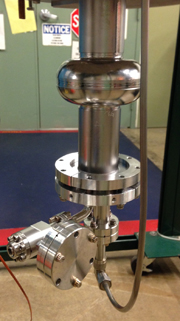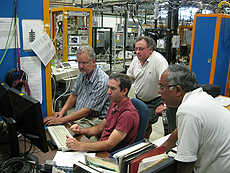New technique for generating RF power may dramatically cut linac costs
 |
| A team from the Accelerator Division has successfully powered this small SRF cavity with a magnetron. Now they aim to power a large, application-specific model. Photo: Brian Chase, AD
|
If you own a magnetron, you probably use it to cook frozen burritos. The device powers microwave ovens by converting electricity into electromagnetic radiation. But Fermilab engineers believe they've found an even better use. They've developed a new technique to use a magnetron to power a superconducting radio-frequency (SRF) cavity, potentially saving hundreds of millions of dollars in the construction and operating costs of future linear accelerators.
The technique is far from market-ready, but recent tests with Accelerator Division RF Department-developed components at the Fermilab AZero test facility have proven that the idea works. Team leaders Brian Chase and Ralph Pasquinelli have, with Fermilab's Office of Partnerships and Technology Transfer, applied for a patent and are looking for industrial partners to help scale up the process.
Both high-energy physics and industrial applications could benefit from the development of a high-power, magnetron-based RF station. The SRF cavity power source is a major cost of accelerators, but thanks to a long manufacturing history, accelerator-scale magnetrons could be mass-produced at a fraction of the cost of klystrons and other technologies typically used to generate and control radio waves in accelerators.
"Instead of paying $10 to $15 per watt of continuous-wave RF power, we believe that we can deliver that for about $3 per watt," Pasquinelli said.
That adds up quickly for modern projects like Fermilab's Proton Improvement Plan II, with more than 100 cavities, or the proposed International Linear Collider, which will call for about 15,000 cavities requiring more than 3 billion watts of pulsed RF power. The magnetron design is also far more efficient than klystrons, further driving down long-term costs.
But the straightforward idea wasn't without obstacles.
"For an accelerator, you need very precise control of the amplitude and the phase of the signal," Chase said. That's on the order of 0.01 percent accuracy. Magnetrons don't normally allow this kind of control.
One solution, Chase realized, is to apply a well-known mathematical expression known as a Bessel function, developed in the 19th century for astronomical calculations. Chase repurposed the function for the magnetron's phase modulation scheme, which allowed for a high degree of control over the signal's amplitude. Similar possible solutions to the amplitude problem use two magnetrons, but doubling most of the hardware would mean negating potential savings.
"Our technique uses one magnetron, and we use this modulation scheme, which has been known for almost a hundred years. It's just never been put together," Pasquinelli said. "And we came in thinking, 'Why didn't anyone else think of that?'"
Chase and Pasquinelli are now working with Bob Kephart, director of the Illinois Accelerator Research Center, to find an industry partner to help them develop their idea. Inexpensive, controlled RF power is already needed in certain medical equipment, and according to Kephart, driving down the costs will allow new applications to surface, such as using accelerators to clean up flue gas or sterilizing municipal waste.
"The reason I'm not retired is that I want to build this prototype," Pasquinelli said. "It's a solution to a real-world problem, and it will be a lot of fun to build the first one."
—Troy Rummler
 |
| The magnetron project members are, from left: Brian Chase, Ed Cullerton, Ralph Pasquinelli and Philip Varghese. Photo: Elvin Harms, AD |
|